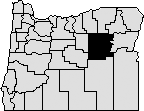
Grant County was established on Oct. 14, 1864, and named for General Ulysses S. Grant, commander of the Union Army during the Civil War. Early in his military career Grant was stationed at Fort Vancouver and assigned to protect the increasing number of emigrants on
the Oregon Trail. Grant County is located in eastern Oregon and was created out of Wasco and Umatilla Counties. At that time Grant County was the largest county in the state. Its size was later reduced by the transfer of land to Lake County and the creation of
Harney and Wheeler Counties. Grant County shares boundaries with 8 counties: Morrow, Umatilla, and Union to the north; Harney to the south; Malheur and Baker to the east; and Crook and Wheeler to the west. It has an area of 4,528 square miles.
Prior to 1864, cases brought to court were tried in The Dalles, county seat of the vast Wasco County. The great distance from the John Day country to The Dalles made law enforcement a difficult problem and imposed a heavy burden on citizens who had a need to transact business at the courthouse. The settlers, feeling a need for a more centralized county government, successfully petitioned the Legislative Assembly.
The first county court session was convened at Canyon City, the county seat, on Nov. 7, 1864. Five officials composed the administration of the county: a judge, sheriff, clerk and two commissioners. A month later the court appointed a treasurer, surveyor, superintendent of schools and coroner. The first county election, held in June 1866, resulted in the election of a county judge, clerk and sheriff. The first courthouse was known as "Dunker's Hall," and the present courthouse was built in 1952. Grant County government consists of a county court made up of a county judge and two commissioners. The county judge retains judicial authority only over probate matters.
After gold was discovered on Whiskey Flat in 1862 the increased
population created a need for county government. It is estimated that within ten days of the original
discovery of gold 1,000 miners were camped along Canyon Creek.
Over $20 million in gold was mined from the Canyon City and Susanville areas.
Following the decline of gold and placer mining, stock raising
and agriculture became the main work of residents.
Grant County contains the headwaters of the John Day River, which has more miles of wild and scenic designation than any other river in the United States. More than 60% of the county's land area is under public ownership, and the county contains parts of four national forests. Principal industries are agriculture, livestock, forestry and recreation.
The first census was in 1870 and counted 2,251 persons. The population of Grant County in 2013 was 7,445. This represented a slight decrease from 2010.